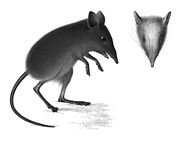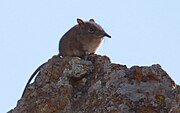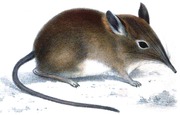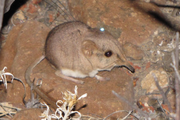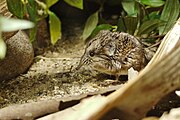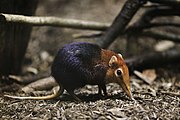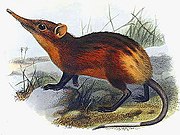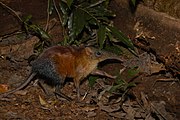List Of Macroscelids
The nineteen extant species of Macroscelidea are grouped into a single family, Macroscelididae, and are split between six genera. Dozens of extinct macroscelid species have been discovered, though due to ongoing research and discoveries the exact number and categorization is not fixed.
Conventions
| Conservation status | |
|---|---|
| EX | Extinct (0 species) |
| EW | Extinct in the wild (0 species) |
| CR | Critically Endangered (0 species) |
| EN | Endangered (1 species) |
| VU | Vulnerable (1 species) |
| NT | Near threatened (0 species) |
| LC | Least concern (13 species) |
| Other categories | |
| DD | Data deficient (4 species) |
| NE | Not evaluated (0 species) |
Conservation status codes listed follow the IUCN Red List of Threatened Species. Range maps are provided wherever possible; if a range map is not available, a description of the macroscelid's range is provided. Ranges are based on the IUCN Red List for that species unless otherwise noted. All extinct species or subspecies listed alongside extant species went extinct after 1500 CE, and are indicated by a dagger symbol "†".
Classification
The order Macroscelidea consists of a single family, Macroscelididae, which contains twenty species divided into six genera. Many of these species are further subdivided into subspecies. This does not include hybrid species or extinct prehistoric species.
Family Macroscelididae
- Genus Elephantulus (round-eared elephant shrews): eight species
- Genus Galegeeska (Horn of Africa elephant shrews): two species
- Genus Macroscelides (long-eared elephant shrews): three species
- Genus Petrodromus (four-toed elephant shrew): one species
- Genus Petrosaltator (North African elephant shrew): one species
- Genus Rhynchocyon (checkered elephant shrews): four species
Macroscelids
The following classification is based on the taxonomy described by Mammal Species of the World (2005), with augmentation by generally accepted proposals made since using molecular phylogenetic analysis.
| Common name | Scientific name and subspecies | Range | Size and ecology | IUCN status and estimated population |
|---|---|---|---|---|
| Bushveld elephant shrew | E. intufi (Smith, 1836) |
Southern Africa
|
Size: 20–28 cm (8–11 in) long, plus 9–15 cm (4–6 in) tail Habitat: Savanna, shrubland, and grassland Diet: Ants, termites, and other small invertebrates, as well as plants |
LC
|
| Cape elephant shrew | E. edwardii (Smith, 1839) |
Southern South Africa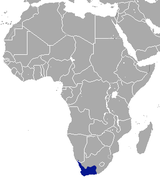
|
Size: 10–13 cm (4–5 in) long, plus 11–15 cm (4–6 in) tail Habitat: Shrubland and rocky areas Diet: Ants and termites, as well as other invertebrates |
LC
|
| Dusky elephant shrew | E. fuscus (Peters, 1852) |
Southern Africa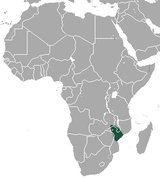
|
Size: 10–13 cm (4–5 in) long, plus 8–12 cm (3–5 in) tail Habitat: Savanna and shrubland Diet: Believed to be invertebrates |
DD
|
| Dusky-footed elephant shrew
|
E. fuscipes (Thomas, 1894) |
Central Africa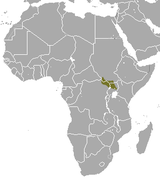
|
Size: 12–15 cm (5–6 in) long, plus 8–10 cm (3–4 in) tail Habitat: Savanna Diet: Believed to be invertebrates |
DD
|
| Eastern rock elephant shrew | E. myurus Thomas, Schwann, 1906 |
Southern Africa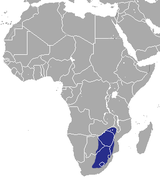
|
Size: 20–29 cm (8–11 in) long, plus 20–29 cm (8–11 in) tail Habitat: Savanna, grassland, and rocky areas Diet: Ants, termites, and other invertebrates, as well as plants |
LC
|
| Karoo rock elephant shrew
|
E. pilicaudus Smit, Robinson, Watson, van Vuuren, 2008 |
Western South Africa
|
Size: 11–12 cm (4–5 in) long, plus 11–15 cm (4–6 in) tail Habitat: Shrubland and rocky areas Diet: Invertebrates |
DD
|
| Short-snouted elephant shrew | E. brachyrhynchus (Smith, 1836) |
Southern and southeastern Africa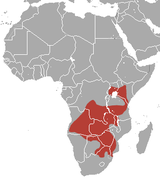
|
Size: 11–13 cm (4–5 in) long, plus 8–11 cm (3–4 in) tail Habitat: Savanna and grassland Diet: Ants and termites, as well as small amounts of plants, fruit, and seeds |
LC
|
| Western rock elephant shrew | E. rupestris (Smith, 1831) |
Southern Africa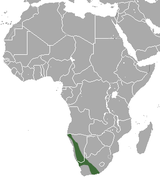
|
Size: 11–13 cm (4–5 in) long, plus 12–17 cm (5–7 in) tail Habitat: Savanna, shrubland, and rocky areas Diet: Invertebrates |
LC
|
| Common name | Scientific name and subspecies | Range | Size and ecology | IUCN status and estimated population |
|---|---|---|---|---|
| Somali elephant shrew | G. revoili (Huet, 1881) |
Horn of Africa | Size: 12–15 cm (5–6 in) long, plus 12–16 cm (5–6 in) tail Habitat: Savanna and shrubland Diet: Invertebrates as well as plants |
DD
|
| Rufous elephant shrew | G. rufescens (Peters, 1878) Six subspecies
|
Eastern Africa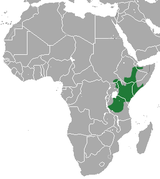
|
Size: 10–20 cm (4–8 in) long, plus 11–17 cm (4–7 in) tail Habitat: Savanna and grassland Diet: Termites and ants, as well as shoots, berries and roots |
LC
|
| Common name | Scientific name and subspecies | Range | Size and ecology | IUCN status and estimated population |
|---|---|---|---|---|
| Etendeka round-eared sengi | M. micus Dumbacher, Rathbun, 2014 |
Northwestern Namibia
|
Size: 8–10 cm (3–4 in) long, plus 8–10 cm (3–4 in) tail Habitat: Shrubland, grassland, and desert Diet: Invertebrates |
LC
|
| Namib round-eared sengi | M. flavicaudatus Lundholm, 1955 |
Namibia | Size: 10–12 cm (4–5 in) long, plus 9–14 cm (4–6 in) tail Habitat: Shrubland and desert Diet: Omnivorous, primarily invertebrates |
LC
|
| Round-eared elephant shrew | M. proboscideus (Shaw, 1800) |
Southern Africa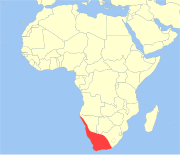
|
Size: 10–11 cm (4–4 in) long, plus 9–13 cm (4–5 in) tail Habitat: Shrubland and desert Diet: Termites, ants, and other small invertebrates, as well as plants |
LC
|
| Common name | Scientific name and subspecies | Range | Size and ecology | IUCN status and estimated population |
|---|---|---|---|---|
| Four-toed elephant shrew | P. tetradactylus Peters, 1846 Nine subspecies
|
Central and southeastern Africa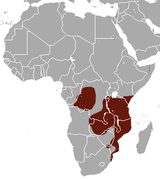
|
Size: 19–23 cm (7–9 in) long, plus 15–17 cm (6–7 in) tail Habitat: Forest, savanna, and shrubland Diet: Termites, ants, and other small invertebrates, as well as plants |
LC
|
| Common name | Scientific name and subspecies | Range | Size and ecology | IUCN status and estimated population |
|---|---|---|---|---|
| North African elephant shrew | P. rozeti (Duvernoy, 1833) Two subspecies
|
Northwestern Africa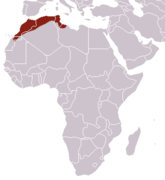
|
Size: 11–13 cm (4–5 in) long, plus 13–16 cm (5–6 in) tail Habitat: Shrubland, rocky areas, and desert Diet: Believed to be ants, termites, and other invertebrates, as well as plants |
LC
|
| Common name | Scientific name and subspecies | Range | Size and ecology | IUCN status and estimated population |
|---|---|---|---|---|
| Black and rufous elephant shrew | R. petersi Bocage, 1880 Two subspecies
|
Eastern Africa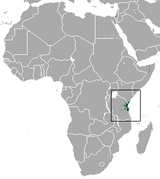
|
Size: 25–31 cm (10–12 in) long, plus 25 cm (10 in) tail Habitat: Forest and shrubland Diet: Omnivorous; primarily ants, termites, and other invertebrates |
LC
|
| Checkered elephant shrew | R. cirnei Peters, 1847 Six subspecies
|
Central and southeastern Africa
|
Size: 22–31 cm (9–12 in) long, plus 17–26 cm (7–10 in) tail Habitat: Forest and shrubland Diet: Invertebrates, as well as small mammals, amphibians, mollusks, birds, and bird eggs |
LC
|
| Golden-rumped elephant shrew | R. chrysopygus Günther, 1881 |
Eastern Kenya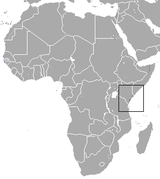
|
Size: 21–31 cm (8–12 in) long, plus 21–27 cm (8–11 in) tail Habitat: Forest and shrubland Diet: Wide variety of invertebrates |
EN
|
| Grey-faced sengi | R. udzungwensis Rovero, Rathbun, 2008 |
Central Tanzania
|
Size: 29–32 cm (11–13 in) long, plus 23–26 cm (9–10 in) tail Habitat: Forest Diet: Unknown |
VU
|
References
- ^ "Fossilworks: Macroscelidea". Paleobiology Database. University of Wisconsin–Madison. Retrieved February 27, 2022.
- ^ Upham, N. S.; Esselstyn, J. A.; Jetz, W. (2019). "Inferring the mammal tree: Species-level sets of phylogenies for questions in ecology, evolution and conservation". PLOS Biology. 17 (12): e3000494. doi:10.1371/journal.pbio.3000494. PMC 6892540. PMID 31800571.
- ^ Wilson, Reeder, pp. 82–85
- ^ Lindsey, David (2012). "Elephantulus intufi". Animal Diversity Web. University of Michigan. Retrieved February 27, 2022.
- ^ Rathbun, G. B. (2015). "Elephantulus intufi". IUCN Red List of Threatened Species. 2015: e.T42661A21289808. doi:10.2305/IUCN.UK.2015-2.RLTS.T42661A21289808.en.
- ^ Kingdon et al., p. 266
- ^ Rathbun, G. B.; Smit-Robinson, H. (2015). "Elephantulus edwardii". IUCN Red List of Threatened Species. 2015: e.T7136A21290344. doi:10.2305/IUCN.UK.2015-2.RLTS.T7136A21290344.en.
- ^ Kingdon et al., p. 268
- ^ Rathbun, G. B. (2015). "Elephantulus fuscus". IUCN Red List of Threatened Species. 2015: e.T42660A21288491. doi:10.2305/IUCN.UK.2015-2.RLTS.T42660A21288491.en.
- ^ Kingdon et al., p. 259
- ^ Kingdon et al., p. 267
- ^ Rathbun, G. B. (2015). "Elephantulus fuscipes". IUCN Red List of Threatened Species. 2015: e.T42659A21288575. doi:10.2305/IUCN.UK.2015-2.RLTS.T42659A21288575.en.
- ^ Jones, Jeremy (2002). "Elephantulus myurus". Animal Diversity Web. University of Michigan. Retrieved February 27, 2022.
- ^ Rathbun, G. B. (2015). "Elephantulus myurus". IUCN Red List of Threatened Species. 2015: e.T42662A21289491. doi:10.2305/IUCN.UK.2015-2.RLTS.T42662A21289491.en.
- ^ Smit, H. A.; Robinson, T. J.; Watson, J.; Jansen van Vuuren, B. (2008). "A New Species of Elephant-Shrew (Afrotheria: Macroscelidea: Elephantulus) from South Africa". Journal of Mammalogy. 89 (5): 1257–1269. doi:10.1644/07-MAMM-A-254.1.
- ^ Smit-Robinson, H.; Rathbun, G. (2015). "Elephantulus pilicaudus". IUCN Red List of Threatened Species. 2015: e.T165924A21291059. doi:10.2305/IUCN.UK.2015-2.RLTS.T165924A21291059.en.
- ^ Kingdon et al., p. 265
- ^ Rathbun, G. B. (2015). "Elephantulus brachyrhynchus". IUCN Red List of Threatened Species. 2015: e.T42658A21288656. doi:10.2305/IUCN.UK.2015-2.RLTS.T42658A21288656.en.
- ^ Gill, Elizabeth (2000). "Elephantulus brachyrhynchus". Animal Diversity Web. University of Michigan. Retrieved February 26, 2022.
- ^ Kingdon et al., p. 276
- ^ Rathbun, G. B.; Smit-Robinson, H. (2015). "Elephantulus rupestris". IUCN Red List of Threatened Species. 2015: e.T7138A21290631. doi:10.2305/IUCN.UK.2015-2.RLTS.T7138A21290631.en.
- ^ Heritage, S.; Rayaleh, H.; Awaleh, D. G.; Rathbun, G. B. (2020). "New records of a lost species and a geographic range expansion for sengis in the Horn of Africa". PeerJ. 8: e9652. doi:10.7717/peerj.9652. PMC 7441985. PMID 32879790.
- ^ Rathbun, G. B. (2017) [errata version of 2015 assessment]. "Elephantulus revoilii". IUCN Red List of Threatened Species. 2015: e.T7137A117060302. doi:10.2305/IUCN.UK.2015-2.RLTS.T7137A21290721.en.
- ^ Kingdon et al., p. 275
- ^ Rathbun, G. B. (2015). "Elephantulus rufescens". IUCN Red List of Threatened Species. 2015: e.T42664A21289073. doi:10.2305/IUCN.UK.2015-2.RLTS.T42664A21289073.en.
- ^ Awaad, Rania (2002). "Elephantulus rufescens". Animal Diversity Web. University of Michigan. Retrieved February 27, 2022.
- ^ Dumbacher, J. P.; Rathbun, G. B.; Osborne, T. O.; Griffin, M.; Eiseb, S. J. (2014). "A new species of round-eared sengi (genus Macroscelides) from Namibia". Journal of Mammalogy. 95 (3): 443–454. doi:10.1644/13-MAMM-A-159.
- ^ Rathbun, G. B.; Dumbacher, J. (2015). "Macroscelides micus". IUCN Red List of Threatened Species. 2015: e.T45434566A45436004. doi:10.2305/IUCN.UK.2015-2.RLTS.T45434566A45436004.en.
- ^ Rathbun, G. B.; Dumbacher, J. P. (2015). "Home range and use of diurnal shelters by the Etendeka round-eared sengi, a newly discovered Namibian endemic desert mammal". PeerJ. 3: e1302. doi:10.7717/peerj.1302. PMC 4636418. PMID 26557433.
- ^ Dumbacher, J. P.; Rathbun, G. B.; Smit, H. A. (2012). "Phylogeny and Taxonomy of the Round-Eared Sengis or Elephant-Shrews, Genus Macroscelides (Mammalia, Afrotheria, Macroscelidea)". PLOS One. 7 (3): e32410. Bibcode:2012PLoSO...732410D. doi:10.1371/journal.pone.0032410. PMC 3314003. PMID 22479325.
- ^ Rathbun, G. B.; Eiseb, S. (2015). "Macroscelides flavicaudatus". IUCN Red List of Threatened Species. 2015: e.T45369877A45435876. doi:10.2305/IUCN.UK.2015-2.RLTS.T45369877A45435876.en.
- ^ Dohring, Alyce (2002). "Macroscelides proboscideus". Animal Diversity Web. University of Michigan. Retrieved February 27, 2022.
- ^ Rathbun, G. B.; Smit-Robinson, H. (2015). "Macroscelides proboscideus". IUCN Red List of Threatened Species. 2015: e.T45369602A45435551. doi:10.2305/IUCN.UK.2015-2.RLTS.T45369602A45435551.en.
- ^ Smith, Mary Alice (2002). "Petrodromus tetradactylus". Animal Diversity Web. University of Michigan. Retrieved February 26, 2022.
- ^ Rathbun, G. B.; FitzGibbon, C. (2015). "Petrodromus tetradactylus". IUCN Red List of Threatened Species. 2015: e.T42679A21290893. doi:10.2305/IUCN.UK.2015-2.RLTS.T42679A21290893.en.
- ^ Tao, Ran (2006). "Elephantulus rozeti". Animal Diversity Web. University of Michigan. Retrieved February 27, 2022.
- ^ Rathbun, G. B. (2015). "Elephantulus rozeti". IUCN Red List of Threatened Species. 2015: e.T42663A21289287. doi:10.2305/IUCN.UK.2015-2.RLTS.T42663A21289287.en.
- ^ Jacques, Abby (2013). "Rhynchocyon petersi". Animal Diversity Web. University of Michigan. Retrieved February 26, 2022.
- ^ Hoffmann, M.; Burgess, N.; Rovero, F. (2016). "Rhynchocyon petersi". IUCN Red List of Threatened Species. 2016: e.T19708A21286959. doi:10.2305/IUCN.UK.2016-1.RLTS.T19708A21286959.en.
- ^ Gasior, Robert (2006). "Rhynchocyon cirnei". Animal Diversity Web. University of Michigan. Retrieved February 26, 2022.
- ^ Hoffmann, M. (2020) [amended version of 2017 assessment]. "Rhynchocyon cirnei". IUCN Red List of Threatened Species. 2020: e.T19709A166489513. doi:10.2305/IUCN.UK.2020-1.RLTS.T19709A166489513.en.
- ^ Kingdon et al., p. 284
- ^ FitzGibbon, C.; Rathbun, G. B. (2015). "Rhynchocyon chrysopygus". IUCN Red List of Threatened Species. 2015: e.T19705A21287265. doi:10.2305/IUCN.UK.2015-2.RLTS.T19705A21287265.en.
- ^ Jansa, Sharon (1999). "Rhynchocyon chrysopygus". Animal Diversity Web. University of Michigan. Retrieved February 27, 2022.
- ^ Rovero, F.; Rathbun, G. B.; Perkins, A.; Jones, T.; Ribble, D.O.; Leonard, C.; Mwakisoma, R. R. (2008). "A new species of giant sengi or elephant-shrew (genus Rhynchocyon) highlights the exceptional biodiversity of the Udzungwa Mountains of Tanzania". Journal of Zoology. 274 (2): 126–133. doi:10.1111/j.1469-7998.2007.00363.x.
- ^ Rovero, F.; Rathbun, G. B. (2015). "Rhynchocyon udzungwensis". IUCN Red List of Threatened Species. 2015: e.T136309A21287423. doi:10.2305/IUCN.UK.2015-2.RLTS.T136309A21287423.en.
Sources
- Schlitter, Duane A. (2005). Wilson, Don E.; Reeder, DeeAnn M. (eds.). Mammal Species of the World. Vol. 1 (3rd ed.). Johns Hopkins University Press. ISBN 978-0-8018-8221-0.
- Kingdon, Jonathan; Happold, David; Butynski, Thomas; Hoffmann, Michael; Happold, Meredith; Kalina, Jan, eds. (2013). Mammals of Africa. Vol. 1. Bloomsbury Publishing. ISBN 978-1-4081-8996-2.

